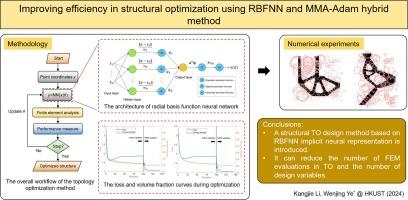Improving efficiency in structural optimization using RBFNN and MMA-Adam hybrid method
IF 8
1区 工程技术
Q1 COMPUTER SCIENCE, ARTIFICIAL INTELLIGENCE
引用次数: 0
Abstract
A significant challenge in traditional topology optimization (TO) methods lies in their low efficiency when handling large-scale design problems, primarily due to repetitive high-dimensional computations. Recently, the fusion of implicit neural representation with conventional structural topology optimization techniques has garnered considerable interest, owing to its various advantages, including the elimination of the need for filters. While this approach can yield design solutions comparable to those from traditional TO methods, it does not lead to clear efficiency gains; in some cases, the number of forward calculations is higher than in traditional methods. This study aims to enhance method efficiency by utilizing the radial basis function neural network (RBFNN) to implicitly represent the structure. Specifically, a set of trainable radial bases shapes and positions is employed to span the structure’s density field. Additionally, a hybrid approach is proposed, combining the method of moving asymptotes (MMA) with the Adam optimizer to update the neural network parameters. This updating technique accelerates convergence and enhances overall efficiency. Through adapting the bases via backpropagation and minimizing the loss function constructed based on traditional TO methods, our approach facilitates achieving design solutions with similar performance but with significantly fewer design variables and performance evaluations compared to traditional TO methods.

利用 RBFNN 和 MMA-Adam 混合法提高结构优化效率
传统拓扑优化(TO)方法面临的一个重大挑战是处理大规模设计问题时效率低下,这主要是由于重复的高维计算造成的。最近,隐式神经表征与传统结构拓扑优化技术的融合因其无需滤波器等多种优势而备受关注。虽然这种方法可以获得与传统拓扑优化方法相当的设计方案,但它并没有带来明显的效率提升;在某些情况下,前向计算的次数要高于传统方法。本研究旨在利用径向基函数神经网络(RBFNN)来隐式表示结构,从而提高方法的效率。具体来说,采用一组可训练的径向基形状和位置来跨越结构的密度场。此外,还提出了一种混合方法,将移动渐近线方法(MMA)与亚当优化器相结合来更新神经网络参数。这种更新技术加快了收敛速度,提高了整体效率。与传统的 TO 方法相比,我们的方法通过反向传播调整基数并最小化基于传统 TO 方法构建的损失函数,有助于获得性能相似的设计方案,但设计变量和性能评估却大大减少。
本文章由计算机程序翻译,如有差异,请以英文原文为准。
求助全文
约1分钟内获得全文
求助全文
来源期刊

Advanced Engineering Informatics
工程技术-工程:综合
CiteScore
12.40
自引率
18.20%
发文量
292
审稿时长
45 days
期刊介绍:
Advanced Engineering Informatics is an international Journal that solicits research papers with an emphasis on 'knowledge' and 'engineering applications'. The Journal seeks original papers that report progress in applying methods of engineering informatics. These papers should have engineering relevance and help provide a scientific base for more reliable, spontaneous, and creative engineering decision-making. Additionally, papers should demonstrate the science of supporting knowledge-intensive engineering tasks and validate the generality, power, and scalability of new methods through rigorous evaluation, preferably both qualitatively and quantitatively. Abstracting and indexing for Advanced Engineering Informatics include Science Citation Index Expanded, Scopus and INSPEC.
 求助内容:
求助内容: 应助结果提醒方式:
应助结果提醒方式:


